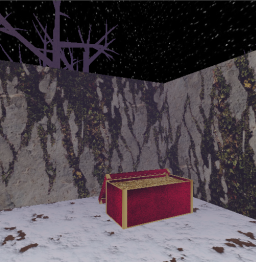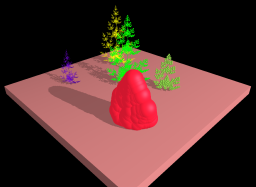Difference between revisions of "Project7Fall11Summaries"
(→Winter Woods Maze (Shannon McPeak, Chris McFarland)) |
|||
| Line 1: | Line 1: | ||
| + | {| border="1" cellspacing="0" | ||
| + | | [[Image:2011-p11.png]] | ||
| + | | | ||
| + | ==A Day in the Forest (Eric Anderson, Huy Tran)== | ||
| + | The general idea would to create a moving sun that would hover over a | ||
| + | simple forest of basic trees. As the sun moves over the environment, it | ||
| + | would expose shadows of the trees and other objects that would be seen. | ||
| + | Because the sun would be "orbiting" around the environment, it would also create | ||
| + | a pseudo night/day effect. The trees of the environment would be created using | ||
| + | a basic L-system whereas the shadow effects would be implemented using simple | ||
| + | shadow mapping. | ||
| + | |||
| + | {| border="1" cellspacing="0" | ||
| + | |+ Controls | ||
| + | | p | ||
| + | | toggle shadow mapping | ||
| + | |} | ||
| + | |||
| + | Features | ||
| + | * Using shadow mapping to create realistic shadows for trees | ||
| + | * Using L-System to create a forest of trees | ||
| + | * Rotating sun(direct light) that orbits the environment, creating a day/night effect. | ||
| + | |||
| + | |} | ||
| + | |||
{| border="1" cellspacing="0" | {| border="1" cellspacing="0" | ||
| [[Image:2011-p4.png]] | | [[Image:2011-p4.png]] | ||
| Line 10: | Line 35: | ||
For our artistic efforts, we focused on creating an appealing winter atmosphere. We attempted to make our maze artistically stylized rather than photorealistic. The mood of the scene is meant to be mysterious. | For our artistic efforts, we focused on creating an appealing winter atmosphere. We attempted to make our maze artistically stylized rather than photorealistic. The mood of the scene is meant to be mysterious. | ||
| − | |||
Technical Features Summary: | Technical Features Summary: | ||
| Line 25: | Line 49: | ||
|} | |} | ||
| − | |||
| − | |||
| − | |||
| − | |||
| − | |||
| − | |||
| − | |||
| − | |||
| − | |||
| − | |||
| − | |||
| − | |||
| − | |||
| − | |||
| − | |||
| − | |||
| − | |||
| − | |||
| − | |||
| − | |||
| − | |||
| − | |||
| − | |||
| − | |||
| − | |||
| − | |||
| − | |||
| − | |||
| − | |||
| − | |||
| − | |||
| − | |||
| − | |||
| − | |||
| − | |||
| − | |||
| − | |||
| − | |||
| − | |||
| − | |||
| − | |||
Revision as of 00:51, 6 December 2011

|
Winter Woods Maze (Shannon McPeak, Chris McFarland)Hidden deep within the snowy forest ruins lies a secret treasure... can you find it? For our final project, we made a maze that takes place in a forest setting during the winter. The story behind our project is that someone is lost in forest ruins looking for a hidden treasure. The objective of the maze will be to find the treasure chest that is hidden somewhere in the maze. The walls of the maze are composed of stone and covered in vines and the floor of the maze is covered in snow. There are large dead looking trees within the maze (since it is winter, the trees have no leaves) and there is also a fog effect. The player is able to navigate with the standard WASD/mouse controls ('a' and 'd' allow the player to strafe). This allows the player to look around in their environment. The mouse look up and down is limited to a fixed range to simulate how far you can tilt your head back. For our technical features, we procedurally generated both the maze itself and trees within the maze. The tree trunks have branches that vary in their orientation. Lastly, we implemented collision detection with the walls so that the player is not able to go through them. The player is able to slide along walls. For our artistic efforts, we focused on creating an appealing winter atmosphere. We attempted to make our maze artistically stylized rather than photorealistic. The mood of the scene is meant to be mysterious. Technical Features Summary:
|
